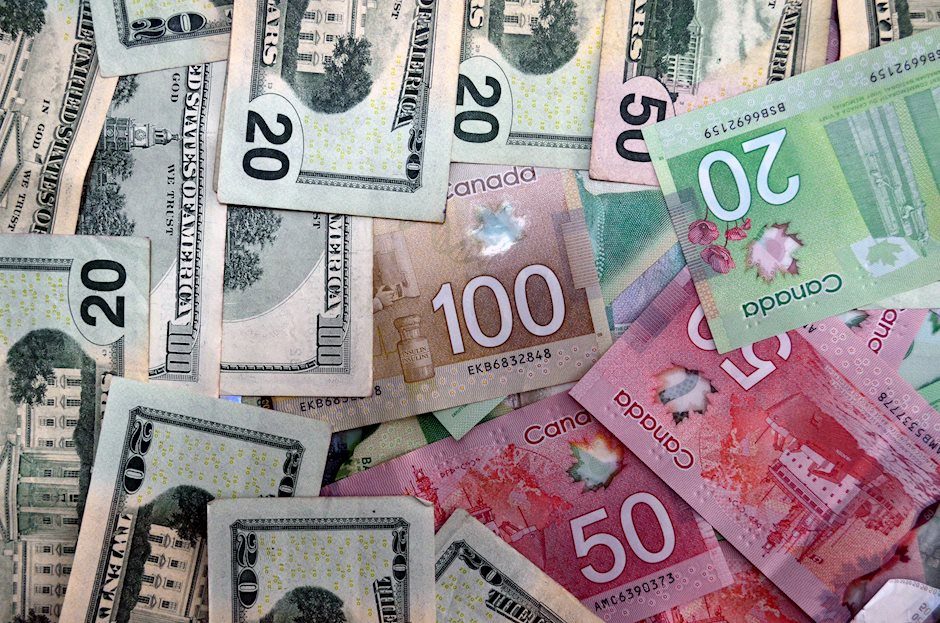USD/CAD extends gains to near 1.3900 due to lower Oil prices
- USD/CAD appreciates as the commodity-linked CAD receives downward pressure from lower crude Oil prices.
- WTI Oil price has dropped over 4% due to an easing in geopolitical tensions in the Middle East.
- CME FedWatch Tool suggests a 92.8% chance of a 25-basis-point rate cut by the Fed in November.

The USD/CAD pair continues its winning streak, rising for the fourth consecutive day and trading around 1.3900 during the Asian session on Monday. The Canadian Dollar (CAD) is facing pressure from declining Oil prices, as Canada is the largest crude Oil exporter to the United States (US).
West Texas Intermediate (WTI) crude Oil price has dropped over 4%, currently trading around $68.40. This decline is attributed to easing geopolitical tensions after Israel's targeted airstrikes on Iran early Saturday, which focused on missile and air defense sites and were less severe than anticipated.
On Friday, Statistics Canada reported a 0.4% increase in Retail Sales for August, totaling $66.6 billion. Sales rose in four out of nine subsectors, primarily driven by gains in motor vehicle and parts dealers. However, Core Retail Sales, which exclude gasoline stations, fuel vendors, and motor vehicle and parts dealers, fell by 0.4% in August.
Traders will be closely watching the speech by Bank of Canada (BoC) Governor Tiff Macklem, who is set to participate in a fireside chat at The Logic Summit in Toronto on Monday.
The upside of the USD/CAD pair could be attributed to the stronger US Dollar (USD) following the recent positive economic data from the United States (US), which has fueled expectations for a more cautious stance from the Federal Reserve (Fed) in November.
According to the CME FedWatch Tool, there is a 92.8% probability of a 25-basis-point rate cut by the Fed in November, with no expectation of a more substantial 50-basis-point cut.
The US Michigan Consumer Sentiment Index rose to 70.5 in October from 68.9 previously, exceeding the forecast of 69.0. Additionally, Durable Goods Orders dropped by 0.8% month-over-month in September, a smaller decline than the anticipated 1.0% decrease.
Canadian Dollar FAQs
The key factors driving the Canadian Dollar (CAD) are the level of interest rates set by the Bank of Canada (BoC), the price of Oil, Canada’s largest export, the health of its economy, inflation and the Trade Balance, which is the difference between the value of Canada’s exports versus its imports. Other factors include market sentiment – whether investors are taking on more risky assets (risk-on) or seeking safe-havens (risk-off) – with risk-on being CAD-positive. As its largest trading partner, the health of the US economy is also a key factor influencing the Canadian Dollar.
The Bank of Canada (BoC) has a significant influence on the Canadian Dollar by setting the level of interest rates that banks can lend to one another. This influences the level of interest rates for everyone. The main goal of the BoC is to maintain inflation at 1-3% by adjusting interest rates up or down. Relatively higher interest rates tend to be positive for the CAD. The Bank of Canada can also use quantitative easing and tightening to influence credit conditions, with the former CAD-negative and the latter CAD-positive.
The price of Oil is a key factor impacting the value of the Canadian Dollar. Petroleum is Canada’s biggest export, so Oil price tends to have an immediate impact on the CAD value. Generally, if Oil price rises CAD also goes up, as aggregate demand for the currency increases. The opposite is the case if the price of Oil falls. Higher Oil prices also tend to result in a greater likelihood of a positive Trade Balance, which is also supportive of the CAD.
While inflation had always traditionally been thought of as a negative factor for a currency since it lowers the value of money, the opposite has actually been the case in modern times with the relaxation of cross-border capital controls. Higher inflation tends to lead central banks to put up interest rates which attracts more capital inflows from global investors seeking a lucrative place to keep their money. This increases demand for the local currency, which in Canada’s case is the Canadian Dollar.
Macroeconomic data releases gauge the health of the economy and can have an impact on the Canadian Dollar. Indicators such as GDP, Manufacturing and Services PMIs, employment, and consumer sentiment surveys can all influence the direction of the CAD. A strong economy is good for the Canadian Dollar. Not only does it attract more foreign investment but it may encourage the Bank of Canada to put up interest rates, leading to a stronger currency. If economic data is weak, however, the CAD is likely to fall.
Author

Akhtar Faruqui
FXStreet
Akhtar Faruqui is a Forex Analyst based in New Delhi, India. With a keen eye for market trends and a passion for dissecting complex financial dynamics, he is dedicated to delivering accurate and insightful Forex news and analysis.

















